Cooper's Hawk 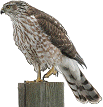
Identification - Pictures and Video
(Accipiter cooperii)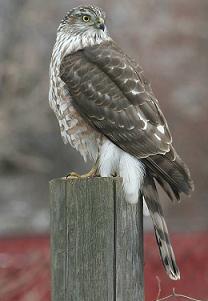
Cooper's Hawk, a raptor named after the naturalist William Cooper
is 14 to 20 inches with a wing span of 2 1/4 to 3 feet.
They have short wings, and a long rounded tail with gray and black
bands, and a white band at the tip. Adults have blue gray
backs, white under parts with fine, thin, reddish bars, red eyes, and
a black cap. The sexes look alike but females are about
a third larger than the males. Younger birds are brown, and
streaked below and the eyes are yellow. They fly with stiff, strong wing beats.
They are often confused with the much smaller
Sharp-Shined Hawk. Cooper's Hawks have a whiter more
finely streaked breast, the legs are thicker, the head is
larger, and younger birds have a reddish hue on the side of
their heads and nape. The Sharp-Shined Hawk's tail is
square.
Photos by Keith
Lee. The camera I use is the Canon
EOS 40D.
Watch video of cooper's hawk on fence
below.
For
other bird videos please visit our Youtube channel and
subscribe or like our videos.
Most videos on my site were taken with the Canon
HG10 camcorder.
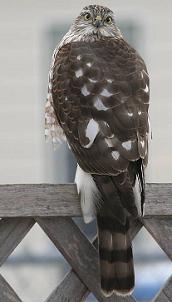
Cooper's Hawk
sound
Their voice is a rapid kek-kek-kek which
sounds much like a flicker, as well
as a mewing like a Sapsucker.
Hawk sound
Preferred Habitat
Some Cooper's hawks have a summer range from
Southern Canada through Northern U.S. The Hawk can be
found in most of the U.S. the entire year. The Northern
hawks migrate for the winter. They like woodlands, riversides, and canyons, and can often be seen soaring over head.
Breeding and Nesting
During courtship the male may feed the female
for up to a month. A pair will mate for life. Their nest, built
mostly by the male in a large
tree is built with sticks and lined with bark, needles and
down. They have been known to take over an old crow's
nest or even build on a squirrels nest. The female will
lay 3 to 5 pale blue to white eggs, which are sometimes spotted. The
eggs will be incubated by both birds for around a month and hatchlings
will be covered with white down. The male will bring
food while the female cares for the young until they fledge
in 25 to 35 days. The young birds will return to the
nest for feeding for 4 weeks after fledging.
Food 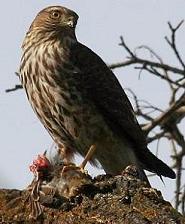
These hawks eat small birds such as robins,
sparrows, starlings, flickers, chickadees, and many more.
They will often perch in a tree or on post to pluck the feathers off their prey.
They also eat mammals such as chipmunks, squirrels, mice, and rabbits.
The hawks also eat insects, and reptiles such as frogs, snakes,
and lizards. When they hunt they move quietly through
the woods getting close enough to capture their prey with a burst of speed.
They are quick, and agile with the ability to navigate through
dense brush at high speeds. They kill their prey by
squeezing it with their talons, but have been known to hold
them under water until they drown.
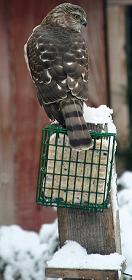 Smaller
birds at backyard feeders may attract Cooper's hawks.
The hawks will swoop down from a nearby tree, and catch one of the
birds in flight as they scatter. Smaller
birds at backyard feeders may attract Cooper's hawks.
The hawks will swoop down from a nearby tree, and catch one of the
birds in flight as they scatter.
The hawks were once called Chicken or Hen
hawks and hunted because they preyed on chickens. It is
now known that the number of chickens they take is insignificant.
To learn about other favorite
birds click here.

|
